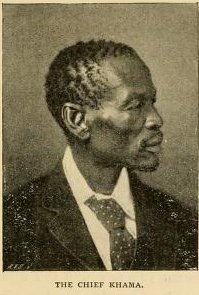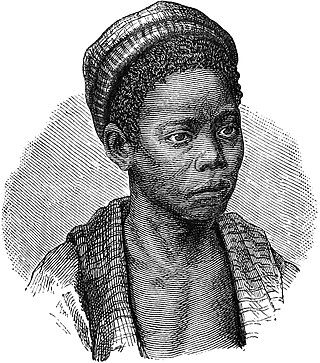Related Research Articles
The Batswana, a term also used to denote all citizens of Botswana, refers to the country's major ethnic group. Prior to European contact, the Batswana lived as herders and farmers under tribal rule.

Khama III, referred to by missionaries as Khama the Good also called Khama the Great, was the Kgosi of the Bangwato people.

The Tswana are a bantu ethnic group native to Southern Africa. Ethnic Tswana made up approximately 85% of the population of Botswana in 2011.
The Bakwena or Bakoena are a large Sotho-Tswana clan in Southern Africa of the southern Bantu group. They can be found in different parts of southern Africa such as Lesotho, Botswana, South Africa and Eswatini. "Kwena" is a Sotho/Tswana/Sepedi word meaning "crocodile", the crocodile is also their totem (seboko).

Molepolole is a large village in Kweneng District, Botswana.

Sechele I a Motswasele "Rra Mokonopi" (1812–1892), also known as Setshele, was the ruler of the Kwêna people of Botswana. He was converted to Christianity by David Livingstone and in his role as ruler served as a missionary among his own and other African peoples. According to Livingstone biographer Stephen Tomkins, Sechele was Livingstone's only African convert to Christianity, even though Livingstone himself came to regard Sechele as a "backslider". Sechele led a coalition of Batswana in the Battle of Dimawe in 1852.
The Bangwaketse are one of the eight principal tribes in Botswana, and are ethnic Tswana. Kanye is the original Bangwaketse village located in the Southern District settled in 1853, originally called Ntsweng Hill. The king of the tribe is King Malope II, son of Seepapitso IV. The Bangwaketse people live in the arid mountainous region of Southern Botswana mentioned in the book Cherub: Guardian Angel. It is bordered by Moshupa, Lobatse, and Jwaneng, and it is a 45-minute drive from Gaborone, the capital city of Botswana. The village is served by Kanye Airport.

The Dithubaruba Cultural Festival is one of the national events celebrated in Botswana and is also marked in the Botswana Calendar of Events. It aims to promote Kweneng cultural heritage and create leisure time for the community.
The History of Botswana includes its pre-state history, its colonial period as the Bechuanaland Protectorate, and its modern history as a sovereign state.
Sechele II Kealeboga Sebele was kgosi of the Kwena tribe in the Bechuanaland Protectorate from 1911 until his death in 1918. His rule was marked by a split within the tribe as opposing dikgosana led by his uncles rejected his authority. Sechele II was succeeded by his son Sebele II.
Motswasele II was the kgosi of the Kwena tribe from c. 1805 until his death c. 1821.
Legwale was a kgosi of the Kwena tribe in the late 18th century. He was preceded by his father Seitlhamo and succeeded by his brother Maleke as regent. Gary Okihiro has contested the idea that Legwale is a single individual, saying that there were two consecutive dikgosi named Legwale who were father and son.

Kelebantse Sebele II (1892–1939) was a kgosi of the Kwena tribe in the Bechuanaland Protectorate. He ruled from 1918 until he was deposed by the British colonial administration in 1931. He was preceded by his father, Sechele II, and succeeded by his brother, Kgari Sechele II.
Seitlhamo was a kgosi of the Kwena tribe. He ruled from the death of his father Motswasele I c. 1785 until his own death c. 1795. He was succeeded by his son Legwale.
Maleke was a regent of the Kwena tribe. He was the son of kgosi Seitlhamo and the younger brother of kgosi Legwale. Maleke became regent of the Bakwena after Legwale died c. 1798. As kgosi, Maleke led an attack against a Bangwaketse village in Kanye to avenge the death of his father. He burned the village, and he is said to have killed Tawana, the uncle of the village's leader, Makaba. A short time later, Maleke died of rabies after he was bitten by a dog. He was succeeded as regent by his younger brother Tshosa until Legwale's son Motswasele II became kgosi c. 1805.
Tshosa was a regent of the Kwena tribe from 1803 to 1807. He became regent following the death of his brother Maleke, who was also a regent, and he held the position until he passed it to the Kwena heir, his nephew Motswasele II. After Motswasele's death, Tshosa led a group of the fractured Kwena tribe. He was killed in an attack by the Bakololo.
Kgari Kealeboga Sechele II was a kgosi of the Kwena tribe in the Bechuanaland Protectorate from 1931 until his death in 1962. He was appointed to the position by the British colonial administration after it deposed his elder brother Sebele II, and his rule was contested by the tribe. He was succeeded by his younger brother Neale Sechele.
Motswasele I was kgosi of the Kwena tribe from c. 1770 until his death c. 1790. He was preceded by his grandfather Motshodi and succeeded by his son Seitlhamo.
Kgabo II was kgosi of the Kwena tribe. He was born a junior son of the Bakwena kgosi Tebele. Tebele was succeeded by Kgabo's older brother Mogopa, and Kgabo was given control of a ward within the tribe. Following a drought, Mogopa wished to move the tribe to find rain, but Kgabo and his village did not accompany them. The Bakwena split into two separate groups: the Bakwena-Kgabo staying in Rathatheng, and the Bakwena-Mogopa that settled in Mabjanamatshwana.
Neale Molaodi Sechele (1915–1985) was kgosi of the Bakwena. He was appointed to the position by the court in 1963 following the death of his brother Kgari Sechele II, and he was forced to abdicate in 1970. As Neale was appointed against the wishes of the people and he often neglected his responsibilities, he was regarded poorly by the Bakwena.
References
- Ngcongco, Leonard D. (1979). "Origins of the Tswana". Pula: Botswana Journal of African Studies. 1 (2): 21–46. ISSN 0256-2316.
- Okihiro, Gary Y. (1976). "Genealogical Research in Molepolole: A Report on Methodology". Botswana Notes and Records. 8: 47–62. ISSN 0525-5090. JSTOR 40979457.
- Otlogetswe, Thapelo J. (2015). "Treatment of Spelling Variants in Setswana Monolingual Dictionaries". Lexikos. 25. doi:10.5788/25-1-1299.
- Schapera, Isaac (1980). "Notes on the Early History of the Kwena (Bakwena-bagaSechele)". Botswana Notes and Records. 12: 83–87. ISSN 0525-5090. JSTOR 40980796.
- Williamson, David (1977). Burke's Royal Families of the World. Vol. II: Africa & the Middle East. Burke's Peerage. ISBN 978-0-85011-029-6.